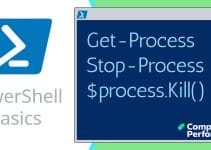Measure-Object: Where-Object Versus -Filter
On this page we have a real-life task for Measure-Object. We are going to compare the performance of PowerShell’s -Filter with Where-Object. In a nutshell, we want to see if it speeds up a script to filter the data stream before piping it into a Where-Object statement.
♣
Our Mission: Measure-Object
Our experiment is to see how fast PowerShell filters objects at source, compared with employing the Where-Object {construction}.
Stage 1: Preliminary Task to List the DLL Files
The task is to obtain a subset of files. For this example we want to list all of the dynamic link library files in the Windows\System32 folder.
Method 1: -Filter
Clear-Host
$WinDll = "C:\Windows\System32\"
Get-ChildItem -Path $WinDll -Filter "*.dll" -Recurse
Learning Points
Note 1: Get-ChildItem has a famous alias gci, which I use in later scripts.
Note 2: Some sub-folders have restrictions which cause errors, thus we could append this instruction: -ErrorAction SilentlyContinue (abbreviates to "ea 4" in Method 2).
Method 2: Where-Object
Clear-Host
$WinDll = "C:\Windows\System32\"
Gci -Path $WinDll -Recurse |
Where-Object Extension -eq ".dll" -ErrorAction SilentlyContinue
Note 3: As an alternative to -Filter we can pipe the list of files into a Where-Object clause.
Stage 2: Use Measure-Object to Compare -Filter and Where-Object
This is the main event, to compare Method 1 with Method 2.
Clear-Host
$WinDll = "C:\Windows\System32\"
# Measuring using Method 1: -Filter
$FiltSource = Measure-Command -Expression {
Gci -Path $WinDll -Filter *.dll -Recurse -ea 4}
# Measuring using Method 2: Where-Object
$WhereObj = Measure-Command -Expression {
Gci -Path $WinDll -Recurse -ea 4 | Where-Object Extension -eq ".dll"}
# Comparing Method 1 and 2
$Diff = [Math]::Truncate($WhereObj.TotalMilliseconds) –
[Math]::Truncate($FiltSource.TotalMilliseconds)
#$Diff = $WhereObj – $FiltSource
"Where takes " + [Math]::Truncate($WhereObj.TotalMilliseconds) + " ms"
"-Filter takes " + [Math]::Truncate($FiltSource.TotalMilliseconds) + " ms"
If($FiltSource -lt $WhereObj)
{Write-Host "`nUsing -Filter is $Diff ms faster than Where-Object."}
Else {Write-Host "Where-Object is $Diff ms faster than -Filter."}
Note 5: By default Measure-Object formats time as hours:minutes:seconds.milleseconds. By combining [Math] and .TotalMilliseconds we are able to get a single number to compare with the other method.
Note 6: The backtick (`) can be tricky, this is why I ended the line with an opening bracket { or, a – (minus), PowerShell realises this syntax means the command continues on the next line.
{
Gci -Path $WinDll -Filter *.dll -Recurse -ea 4}
Not:
`
{Gci -Path $WinDll -Filter *.dll -Recurse -ea 4}
Guy Recommends: A Free Trial of the Network Performance Monitor (NPM) v11.5
v11.5
SolarWinds’ Network Performance Monitor will help you discover what’s happening on your network. This utility will also guide you through troubleshooting; the dashboard will indicate whether the root cause is a broken link, faulty equipment or resource overload.
What I like best is the way NPM suggests solutions to network problems. Its also has the ability to monitor the health of individual VMware virtual machines. If you are interested in troubleshooting, and creating network maps, then I recommend that you try NPM now.
Download a free trial of Solarwinds’ Network Performance Monitor
Maths With Measure Object
I struggled to find the largest number in an array until I hit on this technique of using -Maximum.
Clear-Host
$PrimeNum = @(2,3,5,7,11,13,17,19,23,29,31,37)
$Biggest = ($PrimeNum | Measure-Object -Maximum).Maximum
$Biggest
Note 7: You could use parameters for other math terms, for example -sum or the useful -average.
Research
a) Check the Output
Clear-Host
$PrimeNum = @(2,3,5,7,11,13,17,19,23,29,31,37)
$PrimeNum | Measure-Object -sum
Count : 12
Average :
Sum : 197
Maximum :
Minimum :
Property :
b) Further Research with Get-Help
Clear-Host
Get-Help Measure-Object -full
Note 8: Thanks to -full, we see useful examples.
See More About Measure-Object
Measure-Object computes maths such as sum, average and maximum. Thanks to the concept of an object, this cmdlet can also calculate the properties of text objects, such as the number of words in a document.
See more on PowerShell’s Measure Object
Summary of PowerShell Measure-Object
We use Measure-Object to compare two PowerShell techniques namely: Where-Object and -Filter. The result shows that it is better to filter at source than employ the Where-Object clause.
(Get-WmiObject Win32_PhysicalMemory | Measure-Object Capacity -sum).sum/1mb
If you like this page then please share it with your friends
See more Microsoft PowerShell Examples of Real Life Tasks
• PowerShell Real-life Examples • Test-Connection • Invoke-Expression • Invoke-Command
• Windows PowerShell • Com • PowerShell -Filter Where-Object • PowerShell 3 Rename-Computer
• PowerShell Registry • Compare-Object Registry • Measure-Object • Measure-Command
Please email me if you have a better example script. Also please report any factual mistakes, grammatical errors or broken links, I will be happy to correct the fault.


